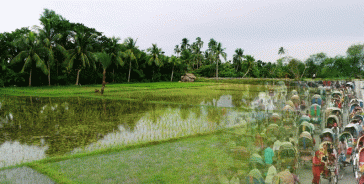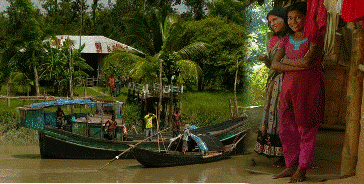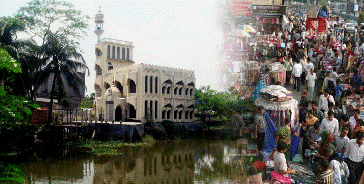
I got an opportunity to take a short trip out of Dhaka during my first fortnight in Bangladesh. VSO invited those volunteers involved in governance to a review meeting of the previous year’s VSO governance programme. The venue was a conference centre run by the Proshika Human Resource Development Centre in Koitta, an hour and a half (theoretically) west of Dhaka. Our destination then was the Manikgonj district of the Dhaka division (see post 8 pt. 13).
Though very brief, this trip is noteworthy because it was my first experience of Bangladesh outside of Dhaka. It was evening when the minibus left the VSO offices and so we hit rush-hour traffic. We crawled through built-up, busy suburbs and passed the vast, sprawling, hectic Gabtali bus station on the western fringes of the city.
Not long afterwards we crossed the Dhaleswari River as the sun was beginning its descent: a gigantic ball of orange in a featureless, white, semi-transparent sky. While at a standstill in a line of traffic on the bridge, I was mesmerised by the hive of activity below. Lines of men and women hauled heavy loads from the holds of barges berthed by the riverbank. They had to negotiate wobbling gangplanks as they struggled, bow-legged, with baskets on their heads, full of what looked like cement and sand. Others carried heaps of stones, piled high and precariously balanced. Once they deposited their loads onshore, they took a second gangplank back to the hold. From up top on the bridge it looked like a series of smoothly running conveyor belts.
 Before darkness descended I could see the signs of Dhaka’s building boom on the outskirts of the city. At first I thought I was seeing ancient towers or temples: these were in fact the single, soaring chimneys of brick kilns. In the evening sun, they looked reddish-purple in colour and almost striking. In Bangladesh there is very little stone. (See post 18.) Almost all land has been reclaimed from riverbeds, or is soon to return to riverbed status: hence the need to bake bricks from alluvial mud in these kilns. Apparently, there are four thousand of them in and around the capital city alone, and every one belches out clouds of unfiltered smoke particles that drift across the already much-polluted city. I recently read about an interesting project in the area of climate change mitigation (UN-funded, I think) that is hoping to address this problem by improving kiln efficiency in the brick-making industry.
Before darkness descended I could see the signs of Dhaka’s building boom on the outskirts of the city. At first I thought I was seeing ancient towers or temples: these were in fact the single, soaring chimneys of brick kilns. In the evening sun, they looked reddish-purple in colour and almost striking. In Bangladesh there is very little stone. (See post 18.) Almost all land has been reclaimed from riverbeds, or is soon to return to riverbed status: hence the need to bake bricks from alluvial mud in these kilns. Apparently, there are four thousand of them in and around the capital city alone, and every one belches out clouds of unfiltered smoke particles that drift across the already much-polluted city. I recently read about an interesting project in the area of climate change mitigation (UN-funded, I think) that is hoping to address this problem by improving kiln efficiency in the brick-making industry.
The remainder of the journey was, unfortunately, in darkness, though there were tantalising glimpses of fleeting, dimly-lit scenes. We finally arrived at the centre and though dark, there was a sense of space and of being surrounded by nature, a calmness that was in complete contrast to the chaos that is Dhaka.
The next day I awoke with the Bangladeshi version of ‘Delhi Belly’, though it was the related headache and dizziness that were the most debilitating. However, I forced myself to go out in the afternoon so that I could take a look at my surroundings. The minute I stepped outside, the heat hit me like a tonne of bricks.
The conference centre is run by the large Bangladeshi NGO, Proshika, and on-site projects include a shrimp hatchery, an electricity substation, a water treatment plant, organic agriculture, plant labs, nurseries and a fabric factory. I would like to have had the opportunity to visit these projects and learn more about this NGO’s work, but time was too short. It felt good though to walk through hushed, green, landscaped gardens. I followed a brown, dusty path round a picturesque lake full of water lilies. Soon I heard laughing and splashing and, in a smaller lake at the other side of the path, I saw a group of semi-submerged women cooling off in the water. They were draped in colourful saris in vivid shades of red, green and yellow and were waving at me. I would have given anything to have jumped in and joined them!

I saw groves of banana plants and mango trees, coconut palms and gargantuan fan palms. Set back from the lake in the shade of the trees there is picturesque, on-site accommodation for staff of the centre. Just as I was about to collapse from weakness, I came upon a conveniently placed wooden bench underneath a stunning and ancient ashok tree (known more commonly as ‘ashoka’ outside Bangladesh). The ashok is my favourite tree in Bangladesh and I will always remember sitting in the tranquil shade of this particularly thick-trunked one, gazing at the lake from beneath its canopy of heavily-laden branches, ablaze with gorgeous orange flowers. There were lots of birds flitting to and fro and a group of children playing nearby. Though physically weak, I felt calm and at peace sitting there and consciously happy to be in Bangladesh. (I later read that the ashok tree has symbolic significance in both Hinduism and Buddhism.)
Unfortunately, I missed the main review meeting but some of my fellow volunteers filled me in on proceedings, a lot of which were in Bangla. It was dusk by the time we started our return journey to Dhaka. As soon as we exited the gates of the centre, life on the streets resumed at full intensity. Along the way, in small bamboo, windowless houses in close proximity to each other, I caught glimpses of families sitting on the floor round a single candle, eating what I presume were bowls of rice. Before long, it became too dark to see anything and the closer we got to Dhaka, the more the traffic began to back-up. Soon though, we were moving through suburbs heaving with life and I was once again engrossed in captivating scenes.
This overnight interlude in Koitta, though short, was interesting. I am looking forward to travelling more in Bangladesh and spending time in this stunning, though volatile, landscape. Hopefully, next time I will get the opportunity to engage and talk with local people too.
Postscript: The NGO Proshika fell into disrepute some months later when the director was jailed on charges of corruption. There were some violent scenes at its offices in the city during protests, but I failed to make sense of the complexities of the story from the newspapers. Perhaps when the furore dies down it will become clearer.

‘Nature 110’, Watercolour by Bangladeshi artist, Ratnashwar Sutradhwar

 On March 15th 2009 I left Ireland to spend 13 months in Bangladesh as a
On March 15th 2009 I left Ireland to spend 13 months in Bangladesh as a 







 I am especially conscious that I am writing about an Eastern culture from the perspective of a Western observer. The opinions expressed are my own - unless otherwise stated. Should you perceive inaccuracy or misrepresentation, in this regard or in any other, or you would like to add something, I would welcome your observations. Leave a comment below the relevant post(s).
I am especially conscious that I am writing about an Eastern culture from the perspective of a Western observer. The opinions expressed are my own - unless otherwise stated. Should you perceive inaccuracy or misrepresentation, in this regard or in any other, or you would like to add something, I would welcome your observations. Leave a comment below the relevant post(s).
The flower of ashoka tree is the symbol for my home state Odisha in India. 🙂
How lovely Manasi! Thank you for telling me. I have wanted to visit Odisha for a long time now. I was so close in the Bay of Bengal. I got as far south as Kolkata, but, unfortunately, there are too many places to visit and too little time in life. But I am hopeful that one day I will get back and visit all the beautiful temples, explore the coastline and Buddhist heritage, attend Hindu festivals and eat some of the delicious food that Odisha has to offer. Dreams can come true (so it’s said)! Thanks again for visiting. Ann